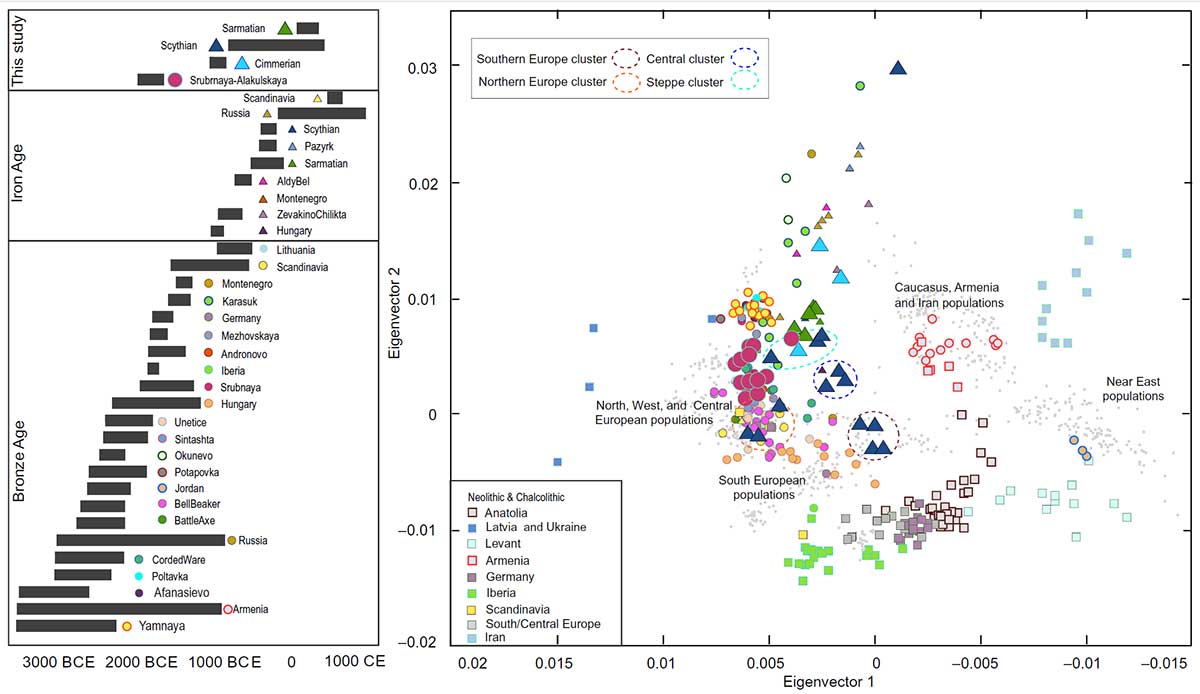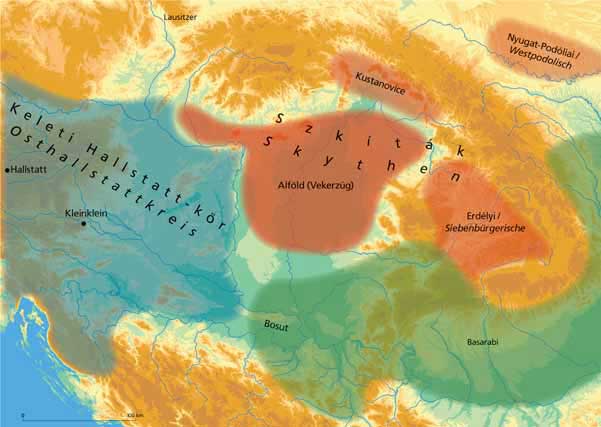New paper (behind paywall) Ancient genomes suggest the eastern Pontic-Caspian steppe as the source of western Iron Age nomads, by Krzewińska et al. Science (2018) 4(10):eaat4457.
Interesting excerpts (emphasis mine, some links to images and tables deleted for clarity):
Late Bronze Age (LBA) Srubnaya-Alakulskaya individuals carried mtDNA haplogroups associated with Europeans or West Eurasians (17) including H, J1, K1, T2, U2, U4, and U5 (table S3). In contrast, the Iron Age nomads (Cimmerians, Scythians, and Sarmatians) additionally carried mtDNA haplogroups associated with Central Asia and the Far East (A, C, D, and M). The absence of East Asian mitochondrial lineages in the more eastern and older Srubnaya-Alakulskaya population suggests that the appearance of East Asian haplogroups in the steppe populations might be associated with the Iron Age nomads, starting with the Cimmerians.
#UPDATE (5 OCT 2018): Some Y-SNP calls have been published in a Molgen thread, with:
- Srubna samples have possibly two R1a-Z280, three R1a-Z93.
- Cimmerians may not have R1b: cim357 is reported as R1a.
- Some Scythians have low coverage to the point where it is difficult to assign even a reliable haplogroup (they report hg I2 for scy301, or E for scy197, probably based on some shared SNPs?), but those which can be reliably assigned seem R1b-Z2103 [hence probably the use of question marks and asterisks in the table, and the assumption of the paper that all Scythians are R1b-L23]:
- The most recent subclade is found in scy305: R1b-Z2103>Z2106 (Z2106+, Y12538/Z8131+)
- scy304: R1b-Z2103 (M12149/Y4371/Z8128+).
- scy009: R1b-P312>U152>L2 (P312+, U152?, L2+)?
You can read here the Excel file with (some probably as speculative as the paper’s own) results.
About the PCA
- Srubnaya-Alakulskaya individuals exhibited genetic affinity to northern and northeastern present-day Europeans, and these results were also consistent with outgroup f3 statistics.
- The Cimmerian individuals, representing the time period of transition from Bronze to Iron Age, were not homogeneous regarding their genetic similarities to present-day populations according to the PCA. F3 statistics confirmed the heterogeneity of these individuals in comparison with present-day populations
- The Scythians reported in this study, from the core Scythian territory in the North Pontic steppe, showed high intragroup diversity. In the PCA, they are positioned as four visually distinct groups compared to the gradient of present-day populations:
- A group of three individuals (scy009, scy010, and scy303) showed genetic affinity to north European populations (…).
- A group of four individuals (scy192, scy197, scy300, and scy305) showed genetic similarities to southern European populations (…).
- A group of three individuals (scy006, scy011, and scy193) located between the genetic variation of Mordovians and populations of the North Caucasus (…). In addition, one Srubnaya-Alakulskaya individual (kzb004), the most recent Cimmerian (cim357), and all Sarmatians fell within this cluster. In contrast to the Scythians, and despite being from opposite ends of the Pontic-Caspian steppe, the five Sarmatians grouped close together in this cluster.
- A group of three Scythians (scy301, scy304, and scy311) formed a discrete group between the SC and SE and had genetic affinities to present-day Bulgarian, Greek, Croatian, and Turkish populations (…).
- Finally, one individual from a Scythian cultural context (scy332) is positioned outside of the modern West Eurasian genetic variation (Fig. 1C) but shared genetic drift with East Asian populations.

Cimmerians
The presence of an SA component (as well as finding of metals imported from Tien Shan Mountains in Muradym 8) could therefore reflect a connection to the complex networks of the nomadic transmigration patterns characteristic of seasonal steppe population movements. These movements, although dictated by the needs of the nomads and their animals, shaped the economic and social networks linking the outskirts of the steppe and facilitated the flow of goods between settled, semi-nomadic, and nomadic peoples. In contrast, all Cimmerians carried the Siberian genetic component. Both the PCA and f4 statistics supported their closer affinities to the Bronze Age western Siberian populations (including Karasuk) than to Srubnaya. It is noteworthy that the oldest of the Cimmerians studied here (cim357) carried almost equal proportions of Asian and West Eurasian components, resembling the Pazyryks, Aldy-Bel, and Iron Age individuals from Russia and Kazakhstan (12). The second oldest Cimmerian (cim358) was also the only one with both uniparental markers pointing toward East Asia. The Q1* Y chromosome sublineage of Q-M242 is widespread among Asians and Native Americans and is thought to have originated in the Altai Mountains (24)
Scythians
In contrast to the eastern steppe Scythians (Pazyryks and Aldy-Bel) that were closely related to Yamnaya, the western North Pontic Scythians were instead more closely related to individuals from Afanasievo and Andronovo groups. Some of the Scythians of the western Pontic-Caspian steppe lacked the SA and the East Eurasian components altogether and instead were more similar to a Montenegro Iron Age individual (3), possibly indicating assimilation of the earlier local groups by the Scythians.
Toward the end of the Scythian period (fourth century CE), a possible direct influx from the southern Ural steppe zone took place, as indicated by scy332. However, it is possible that this individual might have originated in a different nomadic group despite being found in a Scythian cultural context.

Comments
I am surprised to find this new R1b-L23-based bottleneck in Eastern Iranian expansions so late, but admittedly – based on data from later times in the Pontic-Caspian steppe near the Caucasus – it was always a possibility. The fact that pockets of R1b-L23 lineages remained somehow ‘hidden’ in early Indo-Iranian communities was clear already since Narasimhan et al. (2018), as I predicted could happen, and is compatible with the limited archaeological data on Sintashta-Potapovka populations outside fortified settlements. I already said that Corded Ware was out of Indo-European migrations then, this further supports it.
Even with all these data coming just from a north-west Pontic steppe region (west of the Dnieper), these ‘Cimmerians’ – or rather the ‘Proto-Scythian’ nomadic cultures appearing before ca. 800 BC in the Pontic-Caspian steppes – are shown to be probably formed by diverse peoples from Central Asia who brought about the first waves of Siberian ancestry (and Asian lineages) seen in the western steppes. You can read about a Cimmerian-related culture, Anonino, key for the evolution of Finno-Permic peoples.
Also interesting about the Y-DNA bottleneck seen here is the rejection of the supposed continuous western expansions of R1a-Z645 subclades with steppe tribes since the Bronze Age, and thus a clearest link of the Hungarian Árpád dynasty (of R1a-Z2123 lineage) to either the early Srubna-related expansions or – much more likely – to the actual expansions of Hungarian tribes near the Urals in historic times.
NOTE. I will add the information of this paper to the upcoming post on Ugric and Samoyedic expansions, and the late introduction of Siberian ancestry to these peoples.
A few interesting lessons to be learned:
- Remember the fantasy story about that supposed steppe nomadic pastoralist society sharing different Y-DNA lineages? You know, that Yamna culture expanding with R1b from Khvalynsk-Repin into the whole Pontic-Caspian steppes and beyond, developing R1b-dominated Afanasevo, Bell Beaker, and Poltavka, but suddenly appearing (in the middle of those expansions through the steppes) as a different culture, Corded Ware, to the north (in the east-central European forest zone) and dominated by R1a? Well, it hasn’t happened with any other steppe migration, so…maybe Proto-Indo-Europeans were that kind of especially friendly language-teaching neighbours?
- Remember that ‘pure-R1a’ Indo-Slavonic society emerged from Sintashta ca. 2100 BC? (or even Graeco-Aryan??) Hmmmm… Another good fantasy story that didn’t happen; just like a central-east European Bronze Age Balto-Slavic R1a continuity didn’t happen, either. So, given that cultures from around Estonia are those showing the closest thing to R1a continuity in Europe until the Iron Age, I assume we have to get ready for the Gulf of Finland Balto-Slavic soon.
- Remember that ‘pure-R1a’ expansion of Indo-Europeans based on the Tarim Basin samples? This paper means ipso facto an end to the Tarim Basin – Tocharian artificial controversy. The Pre-Tocharian expansion is represented by Afanasevo, and whether or not (Andronovo-related) groups of R1a-Z645 lineages replaced part or eventually all of its population before, during, or after the Tocharian expansion into the Tarim Basin, this does not change the origin of the language split and expansion from Yamna to Central Asia; just like this paper does not change the fact that these steppe groups were Proto-Iranian (Srubna) and Eastern Iranian (Scythian) speakers, regardless of their dominant haplogroup.
- And, best of all, remember the Copenhagen group’s recent R1a-based “Indo-Germanic” dialect revival vs. the R1b-Tocharo-Italo-Celtic? Yep, they made that proposal, in 2018, based on the obvious Yamna—R1b-L23 association, and the desire to support Kristiansen’s model of Corded Ware – Indo-European expansion. Pepperidge Farm remembers. This new data on Early Iranians means another big NO to that imaginary R1a-based PIE society. But good try to go back to Gimbutas’ times, though.

Do you smell that fresher air? It’s the Central and East European post-Communist populist and ethnonationalist bullshit (viz. pure blond R1a-based Pan-Nordicism / pro-Russian Pan-Slavism / Pan-Eurasianism, as well as Pan-Turanism and similar crap from the 19th century) going down the toilet with each new paper.
#EDIT (5 OCT 2018): It seems I was too quick to rant about the consequences of the paper without taking into account the complexity of the data presented. Not the first time this impulsivity happens, I guess it depends on my mood and on the time I have to write a post on the specific work day…
While the data on Srubna, Cimmerians, and Sarmatians shows clearer Y-DNA bottlenecks (of R1a-Z645 subclades) with the new data, the Scythian samples remain controversial, because of the many doubts about the haplogroups (although the most certain cases are R1b-Z2103), their actual date, and cultural attribution. However, I doubt they belong to other peoples, given the expansionist trends of steppe nomads before, during, and after Scythians (as shown in statistical analyses), so most likely they are Scythian or ‘Para-Scythian’ nomadic groups that probably came from the east, whether or not they incorporated Balkan populations. This is further supported by the remaining R1b-P312 and R1b-Z2103 populations in and around the modern Eurasian steppe region.

You can find an interesting and detailed take on the data published (in Russian) at Vol-Vlad’s LiveJournal (you can read an automatic translation from Google). I think that post is maybe too detailed in debunking all information associated to the supposed Scythians – to the point where just a single sample seems to be an actual Scythian (?!) -, but is nevertheless interesting to read the potential pitfalls of the study.
Related
- Corded Ware—Uralic (II): Finno-Permic and the expansion of N-L392/Siberian ancestry
- Corded Ware—Uralic (I): Differences and similarities with Yamna
- Haplogroup R1a and CWC ancestry predominate in Fennic, Ugric, and Samoyedic groups
- The Iron Age expansion of Southern Siberian groups and ancestry with Scythians
- Evolution of Steppe, Neolithic, and Siberian ancestry in Eurasia (ISBA 8, 19th Sep)
- Mitogenomes from Avar nomadic elite show Inner Asian origin
- On the origin and spread of haplogroup R1a-Z645 from eastern Europe
- Oldest N1c1a1a-L392 samples and Siberian ancestry in Bronze Age Fennoscandia
- Consequences of Damgaard et al. 2018 (III): Proto-Finno-Ugric & Proto-Indo-Iranian in the North Caspian region
- Genetic prehistory of the Baltic Sea region and Y-DNA: Corded Ware and R1a-Z645, Bronze Age and N1c
- More evidence on the recent arrival of haplogroup N and gradual replacement of R1a lineages in North-Eastern Europe
